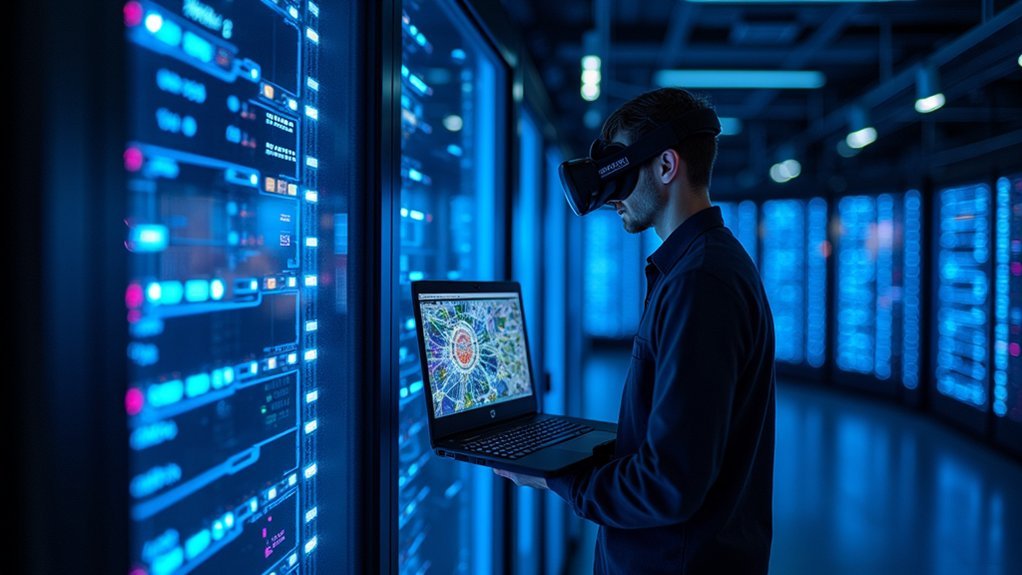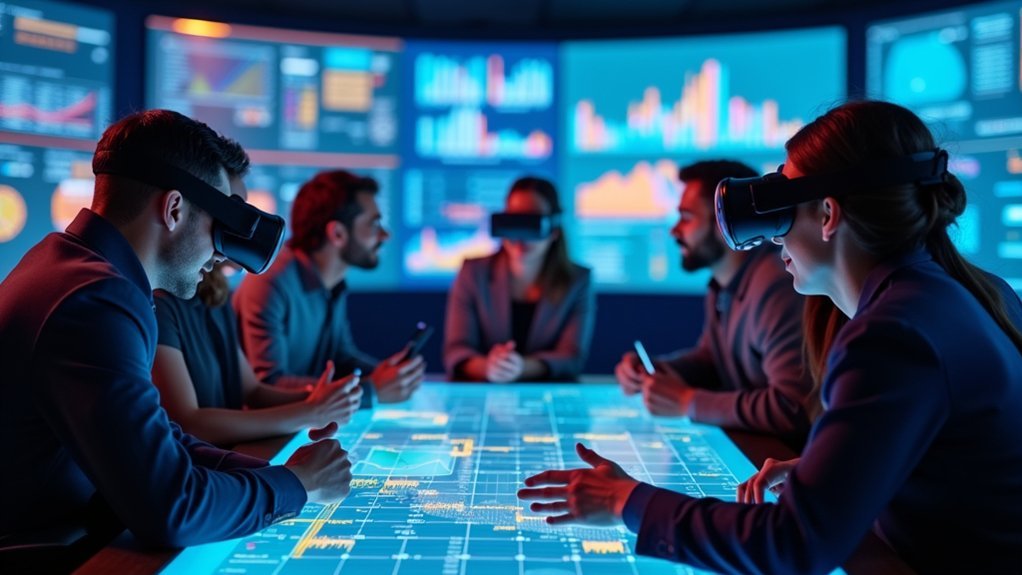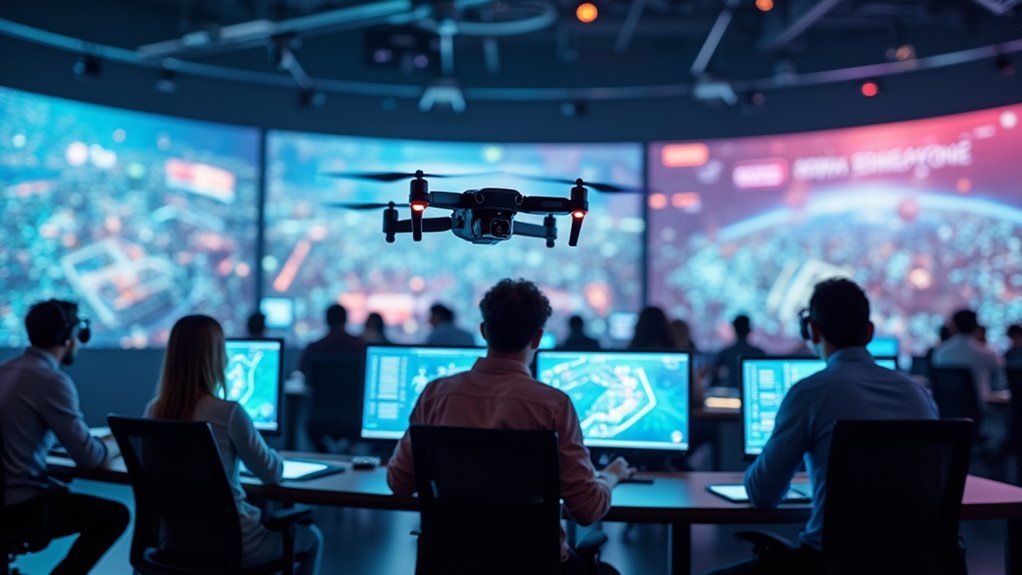You’ll need enterprise VR platforms with robust scalability, high-performance hardware including NVIDIA GTX 1060+ graphics cards and minimum 8GB RAM, plus network infrastructure supporting 25+ Mbps per user. Essential tools include QoS protocols for traffic prioritization, bandwidth management systems for real-time monitoring, centralized content management platforms, and advanced analytics for engagement tracking. Don’t forget staff training systems, space planning tools requiring 6.5 feet per participant, and hybrid coordination platforms. These foundational elements enable deeper implementation strategies.
High-Performance Hardware Infrastructure for Multi-User VR Experiences

When scaling VR events for multiple participants, you’ll need high-performance hardware that can handle the intense computational demands without compromising performance.
Your graphics card should meet minimum specs like NVIDIA GTX 1060 or AMD Radeon RX 480 to guarantee smooth rendering across all VR headsets simultaneously. Pair this with a robust CPU such as Intel i5-4590 or AMD Ryzen 5 1500X, plus at least 8GB RAM to process multiple users effectively.
Don’t overlook connectivity requirements—you’ll need three USB 3.0 ports and one USB 2.0 port minimum for multi-user VR experiences.
Space requirements demand 6.5 feet per participant for safe interactive experiences. High-speed internet bandwidth guarantees seamless data transmission, creating ideal networking opportunities for all participants.
Enterprise VR Platform Selection and Integration Strategies
You’ll need to evaluate how your chosen VR platform meshes with existing systems before committing to any enterprise solution.
Your scalability requirements must align with the platform’s infrastructure capabilities to handle peak user loads without performance degradation.
You should design integration workflows that streamline attendee onboarding, session shifts, and data collection across your entire event ecosystem.
Platform Compatibility Assessment
Although selecting the right VR platform might seem straightforward, you’ll need to dig deeper than surface-level features to confirm your enterprise event succeeds.
Platform compatibility assessment requires matching your event objectives with the right VR technology. Consider whether you’re hosting a virtual conference, educational seminar, or intimate gathering, then evaluate platforms like AltspaceVR or Engage VR accordingly.
Your technical evaluation should focus on three critical areas:
- Infrastructure requirements – bandwidth, scalability, and user experience capabilities
- Integration strategies – seamless data flow with existing event management software
- Customization options – virtual environment flexibility for your brand
Don’t skip pilot testing with real users to gather feedback on their comfort levels.
Collaborate with VR specialists to confirm your platform choice enhances attendee engagement rather than creating technological barriers.
Scalability Infrastructure Requirements
Building on your platform evaluation, the infrastructure backbone determines whether your VR event can handle sudden spikes in attendance or maintain performance under peak loads.
Your scalability infrastructure requirements center on three critical components: robust internet bandwidth to support multiple concurrent users, adequate power supply for sustained VR technology operation, and designated physical spaces that guarantee attendee safety during immersive experiences.
You’ll need reliable networking capabilities that prevent latency issues as participation grows.
Consider implementing mixed reality solutions that blend physical and digital content, creating versatile experiences for both remote and in-person event attendees.
Your infrastructure must accommodate diverse hardware requirements while maintaining consistent performance.
Regular monitoring and updates of your digital content delivery systems guarantee seamless scaling as audience expectations evolve and participation increases.
Integration Workflow Design
When designing your integration workflow, platform selection serves as the foundation that determines how smoothly your VR event will operate across all systems.
You’ll need to evaluate potential VR platform options based on three critical factors:
- Scalability – ensuring the platform can handle your anticipated attendee growth
- User experience – providing intuitive navigation and engagement features
- Customization capabilities – allowing brand alignment and specific event requirements
Your integration workflow should prioritize seamless interoperability between your chosen VR platform and existing event management software. This streamlines registration, attendee tracking, and content delivery processes.
Consider platforms like AltspaceVR for conferences or Engage VR for educational events based on your objectives.
Implement thorough staff training programs and establish regular workflow updates to adapt to emerging technologies and maintain competitive advantage.
Content Management Systems for Immersive Event Experiences
You’ll need to establish clear platform selection criteria that prioritize integration capabilities, scalability, and user accessibility when choosing your CMS for VR events.
Your content creation workflows must support collaborative development while maintaining version control and quality standards across all immersive materials.
You can’t overlook real-time experience management features that enable instant content updates and dynamic adjustments during live events.
Platform Selection Criteria
As VR events grow in complexity and scale, choosing the right content management system becomes a critical foundation for success. Your platform selection criteria should prioritize systems that’ll handle immersive content seamlessly while supporting your event’s unique requirements.
When evaluating a content management system for VR experiences, focus on these essential capabilities:
- Scalability and Performance – Guarantee the platform handles large file uploads and simultaneous user access without compromising quality.
- Integration Capabilities – Verify compatibility with existing event technology, registration systems, and marketing tools.
- Real-time Analytics – Track attendee engagement metrics and interaction data for measuring VR experience effectiveness.
You’ll need user-friendly interfaces that enable efficient content updates, multimedia support for various VR formats, and collaboration tools for team coordination.
The right system streamlines operations while maximizing attendee engagement.
Content Creation Workflows
Beyond selecting the right platform, establishing streamlined content creation workflows becomes the backbone of delivering compelling VR experiences.
You’ll need robust content management systems that support diverse media types—3D models, videos, and interactive elements—while facilitating seamless collaboration between developers, designers, and event planners throughout your event planning process.
Effective CMS solutions enable version control and iterative refinement, ensuring your VR content meets attendee expectations.
You can track user engagement through integrated analytics tools, gathering valuable insights for continuous improvement and personalization.
By implementing content management systems designed specifically for immersive technology environments, you’ll greatly reduce development time while maintaining high-quality standards.
This approach allows for timely updates and enhanced experiences that keep participants engaged throughout your virtual events.
Real-Time Experience Management
Managing VR events requires dynamic content orchestration that responds to attendee behavior and real-time feedback.
Real-time experience management through robust content management systems transforms how you deliver immersive experiences. Your CMS must support multimedia assets including 3D models, videos, and interactive elements to maximize attendee engagement.
Essential CMS capabilities for scaling VR events include:
- Real-time content updates that adapt to live audience responses
- Integrated analytics tools for tracking engagement metrics and behavior patterns
- Cross-team collaboration features connecting content creators, technical support, and planners
You’ll streamline operations while maintaining high-quality experiences through centralized content management.
Advanced analytics tools provide insights that inform future event strategies, while seamless collaboration guarantees your team delivers cohesive immersive experiences that respond dynamically to attendee needs.
Network Architecture and Bandwidth Management Tools
When you’re hosting VR events at scale, your network architecture becomes the invisible foundation that either makes or breaks the attendee experience.
You’ll need a minimum of 25 Mbps per user to guarantee smooth streaming without latency issues that can destroy immersion.
Implementing Quality of Service protocols lets you prioritize VR traffic over standard network activity, considerably reducing lag.
QoS protocols ensure VR traffic takes priority over regular network activity, dramatically cutting lag for seamless virtual experiences.
Your Wi-Fi network should feature multiple strategically-placed access points to handle high user density effectively.
Bandwidth management tools provide real-time monitoring and optimization capabilities, allowing you to adjust resources as attendee demands fluctuate throughout your event.
For maximum stability, consider wired connections for VR stations whenever possible—they’ll deliver a more consistent immersive experience than wireless connections alone.
Real-Time Analytics and Engagement Tracking Solutions

Real-time analytics and engagement tracking solutions transform your VR event from a simple experience into a data-driven powerhouse that reveals exactly how attendees interact with your content.
You’ll gain insights into session duration, interactions, gaze tracking, and social sharing patterns that directly impact your brand awareness and audience connection.
Advanced analytics dashboards enable you to:
- Monitor live engagement levels for real-time content optimization
- Track attendee engagement metrics across all VR experiences
- Analyze behavioral data to enhance future event strategies
Your thorough data reporting validates ROI by correlating interaction metrics with satisfaction scores and overall event success.
You can identify improvement areas instantly, optimize delivery on-the-fly, and design better subsequent events based on attendee preferences and behaviors.
Staff Training Platforms and Support Management Systems
While advanced analytics reveal what’s happening during your VR events, well-trained staff guarantee those experiences actually deliver on their promise through expert guidance and seamless technical support.
Staff training platforms must combine technical operation training with user psychology education. Your team needs hands-on sessions with VR equipment to master troubleshooting and recognize attendee disorientation. Multi-tier support management creates immersive and interactive networking events through specialized roles:
| Role | Primary Function | Key Skills |
|---|---|---|
| VR Experience Guides | Attendee orientation | Communication, patience |
| Technical Support | Equipment troubleshooting | Hardware expertise, problem-solving |
| Safety Monitors | Health monitoring | Medical awareness, observation |
Centralized communication hubs streamline coordination during events, while regular updates on emerging VR trends keep your team prepared for evolving attendee experiences across all networking events.
Space Planning and Safety Monitoring Technologies

Three critical factors determine VR event safety: adequate physical space allocation, real-time movement tracking, and proactive hazard prevention systems.
You’ll need smart space management tools that calculate minimum 6×6 feet per VR station while incorporating buffer zones for seamless shifts between immersive experiences.
Safety monitoring technologies provide real-time attendee tracking to prevent collisions and identify potential hazards.
These systems enhance attendee comfort by monitoring movement patterns and space usage throughout your event.
Essential space planning considerations include:
- Bandwidth allocation – Calculate your bandwidth needs for smooth VR content delivery
- Rest area placement – Position recovery zones strategically to prevent VR fatigue
- Traffic flow optimization – Design pathways that minimize congestion between stations
Implementing these technologies guarantees your scaled VR events maintain safety standards while maximizing participant engagement.
Hybrid Event Coordination and Streaming Infrastructure
Scaling VR events effectively requires hybrid coordination systems that bridge physical and virtual attendees through robust streaming infrastructure. You’ll need platforms like Zoom or Webex that support interactive discussions and breakout rooms for networking sessions. Test your technical setups multiple times, focusing on WiFi performance and video quality to prevent disruptions.
| Infrastructure Component | Scaling Benefit |
|---|---|
| High-quality streaming platforms | Seamless attendee integration |
| Real-time participation tools | Enhanced audience participation |
| Event management software | Streamlined logistics tracking |
| Multiple testing protocols | Disruption mitigation |
Integrate live polls and Q&A sessions to boost attendee engagement across both environments. Your event management software should track registrations, session selections, and provide analytics for continuous improvement. This hybrid event coordination approach guarantees inclusive experiences while maintaining technical reliability.
Frequently Asked Questions
What Is the Best Software for VR?
You’ll find AltspaceVR excels for virtual conferences, while Engage VR works best for educational seminars. FrameVR handles smaller gatherings effectively. Choose based on your specific event objectives and audience size requirements.
What Are the 3 Elements of Virtual Reality?
You’ll experience VR through three core elements: immersive experiences that make you feel present in digital environments, interactivity that lets you manipulate objects, and user agency giving you control over your actions.
How Does Room Scale VR Work?
You’ll move within a tracked play area while sensors monitor your position and translate movements into the virtual world. Your headset and controllers sync with base stations, letting you naturally walk, crouch, and interact.
How Can I Make My VR Experience Better?
You’ll improve your VR experience by creating immersive narratives, training staff thoroughly, ensuring reliable internet and power, choosing social platforms like AltspaceVR, and designing for universal accessibility from the start.





Leave a Reply